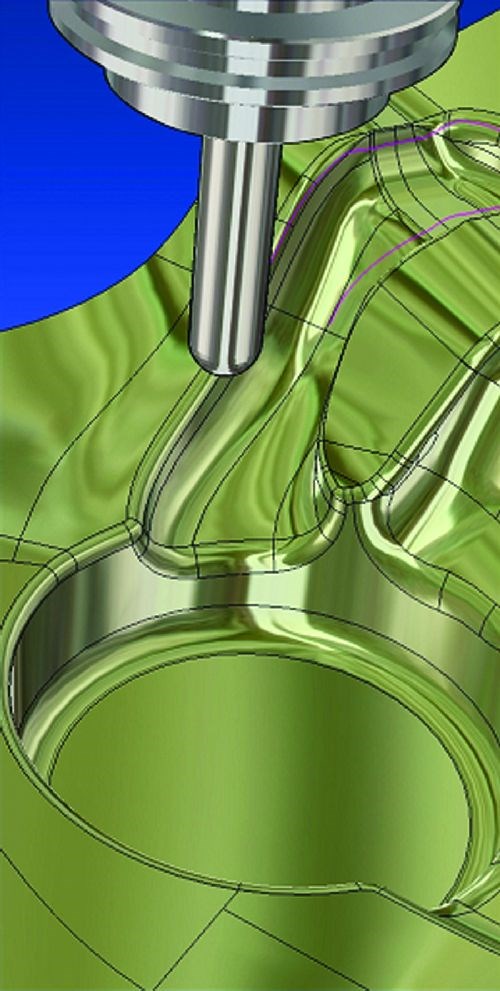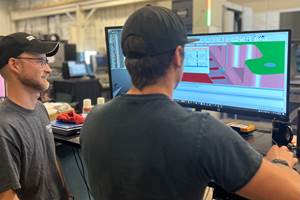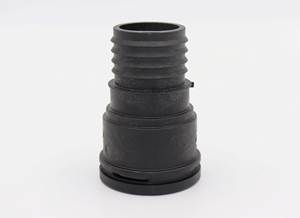Taking the Guesswork out of Complex Machining Processes
“Overall, VISI turns a very complicated process such as machining part geometry into a simple process that can be learned quickly.”
Penn State Erie, The Behrend College—one of four academic institutions in the nation with an accredited Plastics Engineering Program—has found the VISI Machining software from Vero International, Inc. (Wixom, MI) to play a vital role in helping students learn CNC machining quickly to develop high-end NC programs for core and cavity work—particularly in their Rapid Commercialization class. This class follows the Rapid Prototyping class and teaches students how to get a product to market, from concept to a design model, to tooling manufacturing and molding, and finally to completed, assembled and decorated parts.
Approximately five years ago, Jon Meckley, Chair of the Plastics Department, came across VISI while looking for a new machining system for the Penn State Behrend Plastics Lab to replace its previous one—which had proven too difficult for the students to use. Features he sought in a new system were ease-of-use for the students, but also depth-of-function for creating the high-end toolpaths necessary to machine sophisticated mold core and cavity work.
“We settled pretty quickly on VISI,” Meckley recalls. “Compass Technologies, our local VISI-Series dealer, came in to talk to the faculty about VISI-Flow for mold fill analysis. During the discussion we learned of VISI’s machining program. We asked for a demo, which they gave to us.” After conducting some Internet R&D on other packages, Meckley decided VISI would be the best program for his students to get introduced to the world of machining—and still turn out a quality product because of its ease of use.
Programming Ease
“The student program in the Lab is all about teaching students the entire process of bringing a plastic product design to market—from part design and verification, to tool design, tool build, and product manufacturing,” Meckley notes. “The inability to create the correct toolpaths in our previous system detracted from our ability to educate students on how to properly create a toolpath as we illustrated the process of bringing a product from art to part. Every once in a while the old system would cut things off where it shouldn’t or just put extra unnecessary moves in the NC programs. I wanted a system that would do it correctly.”
“The product our students design and manufacture is a toy racecar—made using a two-plate mold that consists of a standardized mold base with front loadable inserts,” Meckley explains. “The students face mount their inserts in a mold base in an injection molding machine at the end of the semester and make a car or two,” he says.
The class, a technical elective, is divided into three parts: Roughing, Semi-Finishing and Finishing. First, Meckley’s students do all of the design work in Pro/Engineer. Then, using Promold, create the 3D models for the mold inserts. After giving the students a basic education on how to program a CNC machine to cut the inserts the students are given one instruction—the maximum speed limit of the cutter, so as to not break the milling cutter. “But, other than that, the VISI software is designed to protect the students from ever gouging—provided the parameters are properly programmed—the steel into the core and cavity surfaces that define the inserts,” Meckley states. “Students are able to try many different types of toolpaths for roughing, semi-finishing and finishing the inserts until they have found the best ones that yield a smooth finished surface to the inserts within the least amount of run time.
“Roughing with VISI is easy,” Meckley continues. “You just put the speeds, feeds and parameters in correctly, and VISI does the rest. If the students have plugged in the wrong information then, when they start machining, they’re able to see their mistakes quickly and fix them.”
Senior Maureen Cress—who is majoring in Plastics Engineering Technology—finds VISI easy
to learn—and use. “After learning the basics of VISI and with my work using other types of engineering programs, I found VISI to be user-friendly and straightforward,” she comments. “It was a simple program to grasp and I had very little difficulty using the program.”
Cress liked how VISI showed her the path of the different cuts and animated them to see how the cut was going to be made. “Visualizing what I was telling the program to do made it much easier to understand how to do different cuts,” she notes. “It was very helpful to use VISI to create a CNC program to cut the core and cavity halves of our car mold. Without this program, we would have had to learn how to manually program the CNC, and this would have required much more class time and out-of- class time. VISI made this portion of the project much simpler and much more accurate and advanced.”
Fellow Plastics Engineering Technology major Kevin Eden—also a senior—agrees that VISI is simple to learn. “Once the assembled part and stock material is imported into VISI, there are only a few easy steps left for creating a basic part,” Eden says, “picking which tool you wish to cut with, choosing the limits on how far the material needs to cut, and any allowances that you wish to use. Overall, VISI turns a very complicated process such as machining part geometry into a simple process that can be learned quickly.
“Just by setting a few limits and allowances, the program was able to determine the exact paths that the tooling needed to go in remove the correct amount of material,” Eden continues. “It was helpful with the project because our part geometry was too complicated to be machined with mills or drill presses. VISI allowed us to determine the correct tooling paths while creating the program for the CNC machine. We were able to make the CNC program for complex geometry inserts all within a couple of hours.”
Since the Plastics Engineering Program is a 134-credit program and this machining course only covers two of those credits, Meckley explains it is important to maximize their class time. “We are not trying to turn out machinists, but we want them to understand the machining process in terms of how it fits in the overall manufacturing process,” he states. “The program is easy to use and students pick it up quickly, so they get a good feel for the machining process when using VISI.
“It’s not good enough to just design a product,” Meckley continues. “You also have to know and comprehend what mold designers and moldmakers go through in the manufacturing of the product. A better part design is one that is easy to manufacture and that’s what the class is all about—to learn better ways to bring a more manufacturable product to market quicker. VISI is the link between what the students do on the computer and what they can hold in their hand.”
Once the students finish machining the car molds, they injection mold their own parts, paint them, and then put the cars together with a standard frame and standard wheel assemblies courtesy of Fisher-Price®, Meckley adds. Then the students and sixth graders gather for the aforementioned end-of-semester, on-campus car race.
A CNC Machining Education
Meckley is very pleased with VISI-Machining in his Rapid Commercialization class. “Because of VISI, my students are able to pick up the entire subject matter of CNC machining within two class periods,” he notes. “We cover an overview of machining, then go on to cover roughing, semi-finishing and finishing NC toolpaths. After that, students are able to work on developing their own core and cavity NC programs.
“What’s more,” Meckley adds, “it’s very rewarding to see our students go off into industry grounded in world-class, state-of-the-art technology.”
For More Information
Pennsylvania State University at Erie / REDC - School of Engineering / (814) 898-6147 jam135@psu.edu / http://psbehrend.psu/edu
Compass Technologies / (440) 734-9600
al.foote@compasstech.com / compasstech.com
Related Content
CAD/CAM Software Reduces Delivery Times by 70% With a Six-Month ROI
Single integrated CAD/CAM package reduces translation errors, simplifies design process, improves shop efficiency and shortens tool lead times.
Read MoreFive-Axis Vertical Mill Increases Mold Shop Capacity by Reducing Setups
Zero Tolerance now processes blocks — from squaring to waterline drilling to rough and finish milling — on a single five-axis CNC mill, reducing setups and moving blocks in/out of multiple machines without sacrificing accuracy and surface finish.
Read MoreHow to Harness 3D Scanning for Mold Tool Repairs
3D scanning supports the repair of molds with no history, drawings or design files.
Read MoreIntegrated CAD/CAM Streamlines Electrode Manufacture, Improves Quality
A focus on electrode design and automation helps toolroom improve efficiency, reduce tooling costs and deliver higher quality products.
Read MoreRead Next
Software Consolidation Advantages Identified in an Eco-Friendly Milk Dispenser Job
Software aided MNB Moulds when it manufactured tooling for a number of the milk dispenser components including a two-cavity tool for the handle, a two-cavity tool for the lid, a four-cavity tool for the spout spike and an eight-cavity tool for the clamping mechanism for this project.
Read MoreHow to Use Strategic Planning Tools, Data to Manage the Human Side of Business
Q&A with Marion Wells, MMT EAB member and founder of Human Asset Management.
Read MoreHow to Use Continuing Education to Remain Competitive in Moldmaking
Continued training helps moldmakers make tooling decisions and properly use the latest cutting tool to efficiently machine high-quality molds.
Read More
























